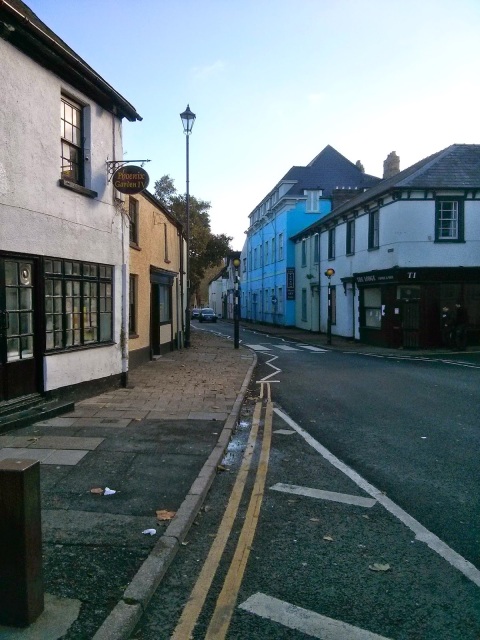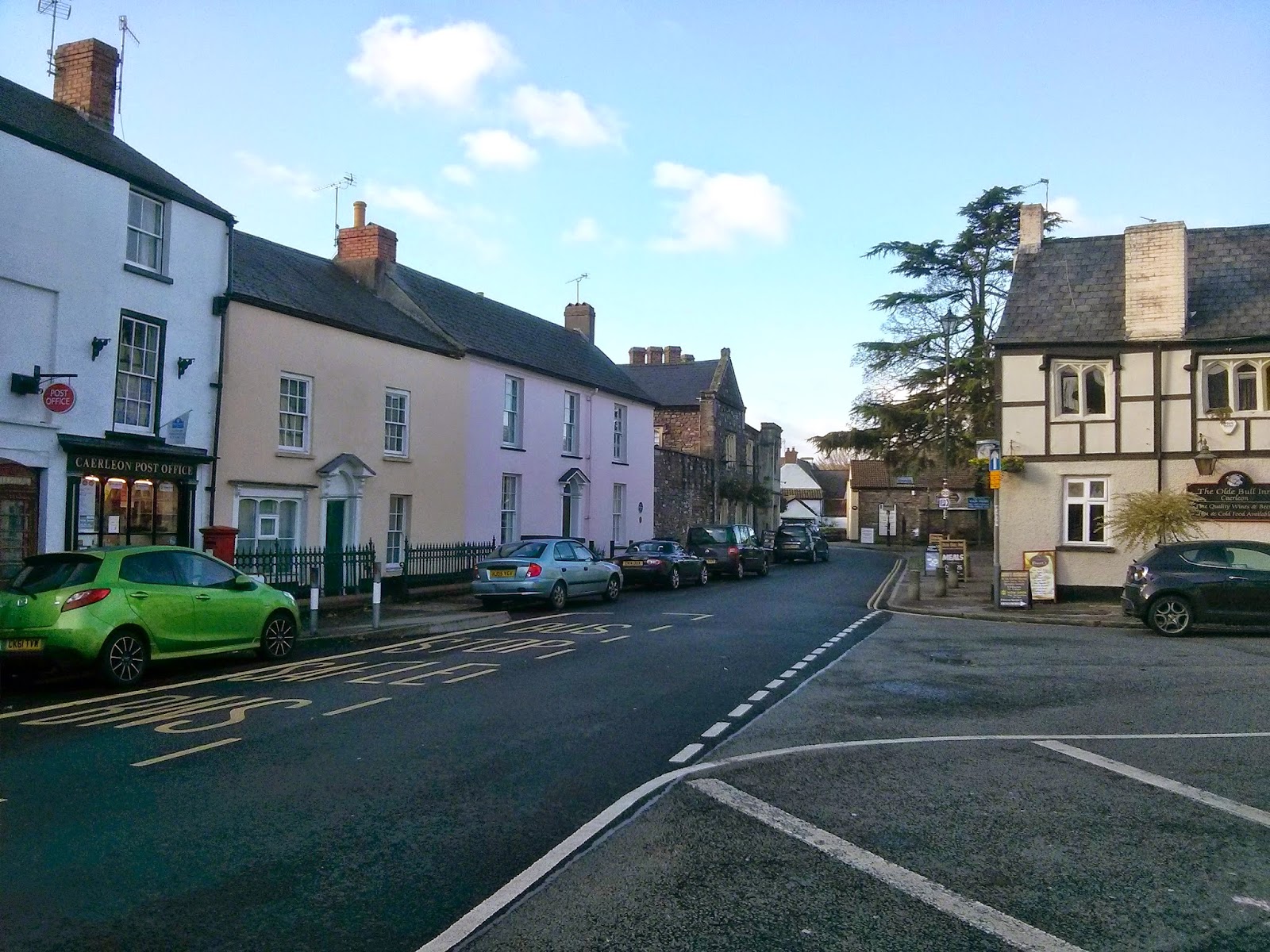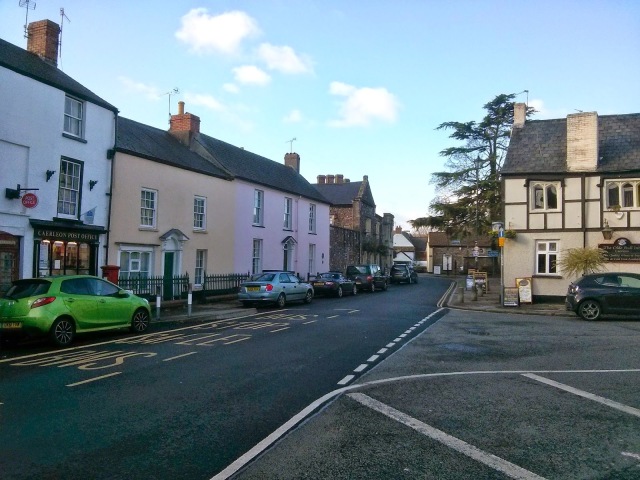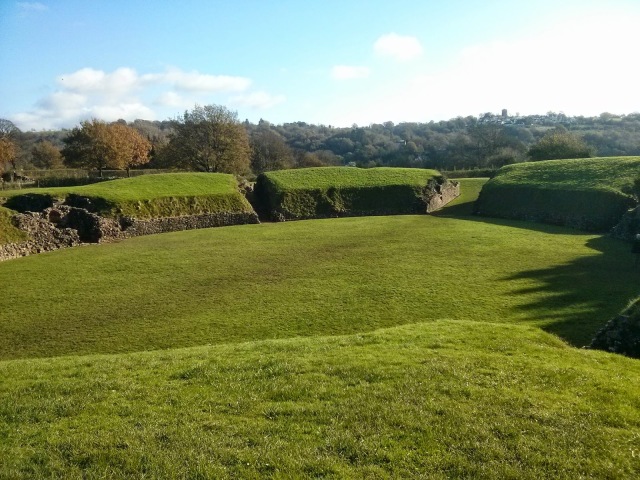This is the second stop on the Great Welsh Tea Towel Adventure. Remember that this whole thing is a work in progress, so if you happen to know anything about the towns, villages and cities I’m planning to visit, don’t wait until after the fact to tell me what I should have done — give me your suggestions on what to see, what to do, where to eat, when to visit, etc. Thanks!
__________
Caerleon –– according to the tourism officials at Caerleon –– was once one of the most important places in Britain. It was home to a large Roman fortress and thereafter the setting for a number of Arthurian legends.
Yeah. Bet you didn’t know King Arthur was Welsh, did you? He was. He gets mentioned a lot in the Mabinogi, a collection of folk tales that has somewhat biblical status in Wales. And even before then he was being linked with Caerleon. Some versions of his tale say he came from there and others claim simply that he held court there.
Somehow, however, Caerleon’s prestigious beginnings didn’t translate well beyond the Middle Ages. These days it is little more than a quaint suburb of Newport where visitors may find themselves somewhat challenged to find anything worth taking a picture of.
That said, it is somewhat exemplary of Wales. There is was a castle. There are Roman ruins. And the people of the town don’t really seem to give a damn about either. That is such a Welsh thing. You have history falling out of your ears and you just don’t give a fuck. These days all that’s left of the castle is a crumbling bit of tower next to a pub, and the Roman ruins are crowded by rugby pitches and a school.
There is also evidence that Caerleon may be the home of the Mari Llwyd tradition, which is the most Welsh thing ever. It involves singing a bunch of boring songs and waving about a horse’s skull for reasons no one understands until you either get bored or people bribe you to go away.
Huge chunks of Welsh folk tradition, song, dance, food and storytelling were obliterated forever by the unrelenting no-funness of puritanism and thereafter Methodism in Wales (a). The Mari Llwyd is one of the very, very few things to have survived long enough for us to even know it existed. But, of course, no one in Caeleon cares.
I used to teach Welsh at the school that overlooks the Roman ruins. That is, I taught night classes there. Getting students to show up was a challenge. Eventually, my class was reduced to just two regular attendees. Often no one would show up for classes at all. In a trick I learned from reading Mihangel Morgan novels (b), I took to marking absent students as present so the council wouldn’t cancel my class and put me out of a job.
I didn’t have a car or motorbike in those days, and getting to Caerleon was always an unreasonably arduous process due to the infrequency of buses. So, I’ll admit that Caerleon instils in me a kind of sadness, a “Is this all there is?”-ness. This place was the end of the dream for me. I had come to Wales, worked incredibly hard to learn the language and culture, and all it had earned me was a small-time teaching gig in a town where the Welshness had withered away before I was even born. Sometimes, when I’d find myself again with a studentless classroom and an hour’s wait for the next bus, I would walk out to the remains of the Roman barracks, sit on the walls and cry because I hated my life so much.
This speaks to something I mentioned when I first came up with the idea for this tea-towel-driven adventure: I carry a great big heaping lot of bitterness and animosity toward Wales. Several of the worst years of my life have been spent in this country. I want to overcome that, but there will be times during this adventure when it will all come flooding back and I’ll just want to scream and set things on fire. That’s kind of how I felt upon visiting Caerleon again.
Which is a really unfair amount of weight to put on the shoulders of an otherwise quaint British suburban town. In and of itself, there is nothing too terribly offensive about Caerleon. Nor too terribly exciting.
From a motorcycling standpoint, you can cover the town in under three minutes. That’s assuming you want to see it twice. There is a single one-way road that runs in a circle around/through the town taking you on a speedy tour past Roman remains and a handful of interesting looking pubs.
If you ignore the soul-destroyingly uninteresting 1970s semi-detached homes on Caerleon’s outskirts, it is a town set within an attractive valley of the River Usk. Thanks in part to the fact Caerleon’s train station closed in the 1960s and buses are so rare, it seems most of the undesirable elements of Newport don’t make it this far upriver.
If you’ve got good weather and sturdy legs, you can use Caerleon as the starting point for the 25-mile Usk Valley Walk, which will eventually land you in the very charming and very much worth visiting (even though it’s not on my tea towel map) town of Abergavenny. Jenn and I have walked various sections of the route and I’ve always come away from the experience feeling inspired.
So my point is, Caerleon is a very nice spot indeed. As long as you’re not me.
Before heading here, I had thought I might stop and have lunch at one of the pubs that overlook the River Usk, the day being just barely warm enough for me to sit outside. But when I got to Caerleon I managed only to take a picture of the old Roman amphitheatre before a deep feeling of needing to be elsewhere kicked up inside me. I rode two or three loops around the town before deciding there was nothing worth taking a picture of, then sped away.
 |
| Caerleon town centre |
____________________
(a) One of the things that makes Wales harder to love than its Celtic cousins of Ireland and Scotland is that it lacks the sort of songs, dances, foods and traditions those places have. Protestantism spent a very long time stifling creativity in Wales, to the point that well into the late 1800s it was considered sinful to read or write a work of fiction, because fiction is inherently a lie, and to lie is a sin.
(b) In one of Morgan’s novels — either Dirgel Ddyn or Y Ddynes Ddirgel, I can’t remember which — the main character is a Welsh teacher who creates a false student for the sake of having the bare number of students to hold a class.




The Museum (free) is good…Missed it??
LikeLike
Yes, I'm afraid I did. As I move forward with this little project I'm finding that I need to do a little more research into a place before going there.
LikeLike
Worth a run back Chris. Saw a time team programme a few years back- thousands of roman soldiers housed there over a hundred years or more. Good stuff in there….
LikeLike